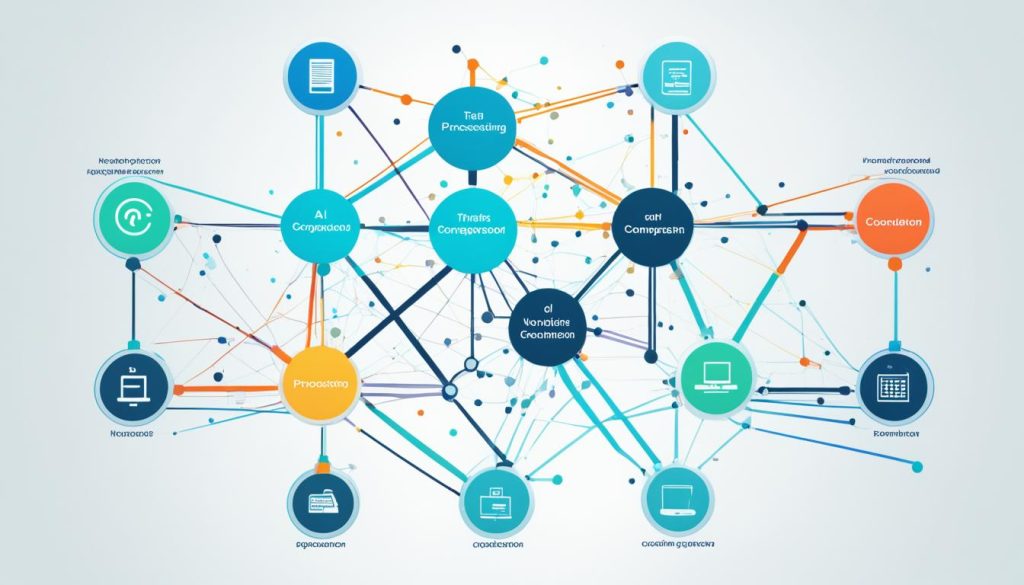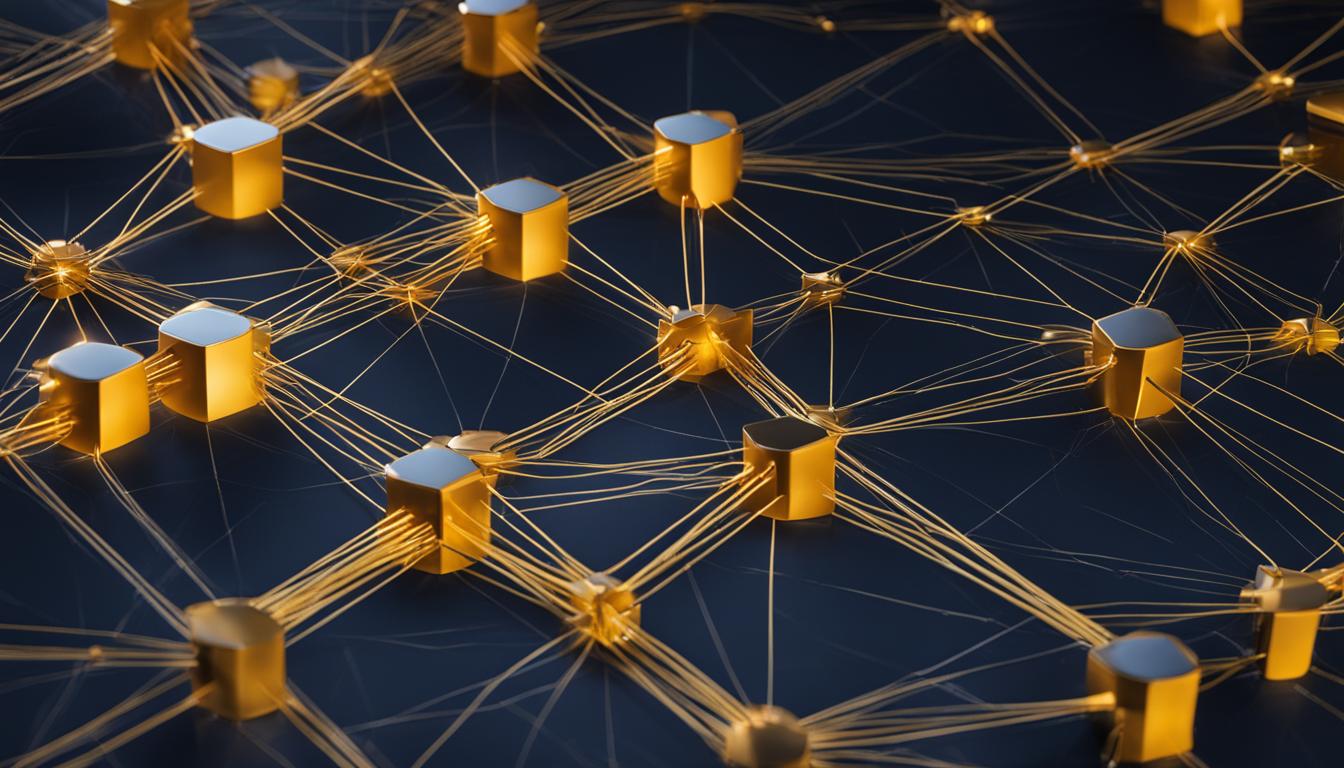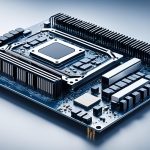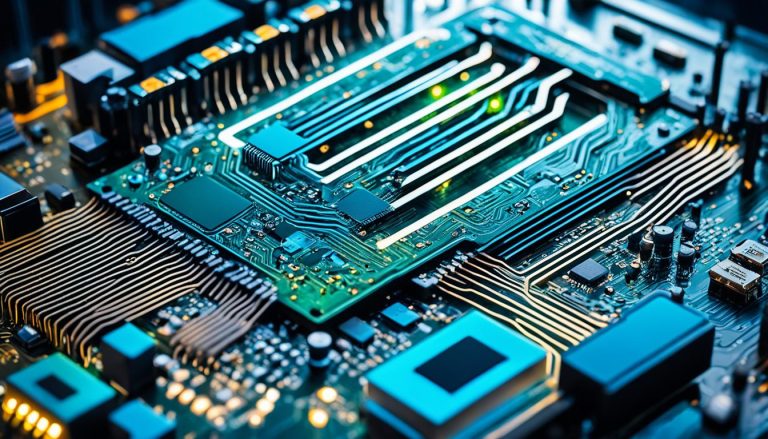As organizations increasingly adopt artificial intelligence (AI) technologies, the need for a robust network infrastructure to support AI workloads becomes essential. Ensuring that your network infrastructure is capable of handling the demands of AI is crucial for achieving optimal performance and scalability in your AI initiatives.
Meta, a leading AI company, has been at the forefront of building a future-proof infrastructure for AI, encompassing cutting-edge hardware like MTIA v1 and large language models like Llama 2. They understand the importance of designing and operating network infrastructure specifically tailored to cater to AI workloads, including ranking and recommendation algorithms, as well as the upcoming challenges posed by new generative AI tools.
Having a robust network infrastructure in place enables organizations to process and analyze vast amounts of data, facilitating the development and deployment of AI models that can drive innovation and insights across various industries.
Key Takeaways:
- Building a robust network infrastructure is essential for supporting AI workloads.
- Designing and operating network infrastructure tailored to AI requirements is crucial.
- Meta’s approach to building future-proof infrastructure sets an example for organizations.
- A solid network infrastructure enables efficient processing and analysis of AI data.
- Ensuring optimal performance and scalability is vital for AI initiatives.
Networking for GenAI Training and Inference Clusters
Jongsoo Park and Petr Lapukhov from Meta discuss the unique requirements of new large language models and how Meta’s network infrastructure is evolving to support the emerging GenAI landscape. They delve into the challenges posed by the scale and complexity of GenAI models and highlight the need for custom network designs.
GenAI Training and Inference Clusters demand robust networking infrastructure to facilitate seamless data transfer and communication between AI components. Meta’s network infrastructure plays a vital role in this process, ensuring optimal performance and scalability.
As AI models continue to grow in size and complexity, efficient data exchange between computation units becomes critical. GenAI Training and Inference Clusters require low-latency and high-bandwidth connections to support the computational demands of AI workloads. These clusters consist of multiple GPUs, CPUs, memory units, and storage devices, all interconnected through a dedicated networking infrastructure.
Meta recognizes the need for custom network designs to address the challenges posed by GenAI models. The scale and complexity of these models necessitate tailor-made networking solutions that can effectively handle the massive amount of data being processed.
Custom Network Designs for GenAI
Meta’s approach to networking for GenAI involves the creation of custom network designs specifically optimized for AI workloads. By implementing dedicated networking infrastructure, Meta ensures that high-speed data transfers occur seamlessly within GenAI Training and Inference Clusters.
“The key to supporting GenAI is to create an infrastructure that can handle the enormous computational demands and data transfers required. Custom network designs enable us to build the necessary network architecture that caters to these specific requirements.”
Meta’s custom network designs incorporate technologies such as multi-path routing, traffic engineering, and load balancing. These innovations help optimize data flow and minimize latency, resulting in improved AI model training and inference performance.
In addition to addressing the computational requirements, Meta’s networking infrastructure also considers the scalability and flexibility needed for GenAI workloads. As large-scale language models continue to evolve, the network must adapt and accommodate the growing demands efficiently.
Meta’s commitment to building a robust network infrastructure for GenAI Training and Inference Clusters ensures that AI workloads can be executed efficiently and effectively. The ongoing advancements in networking technology, coupled with customized designs, empower Meta to support the evolving needs of AI models.
In the next section, we will explore Meta’s network journey and how they enable AI services through their network infrastructure.
Meta’s Network Journey to Enable AI
Hany Morsy and Susana Contrera from Meta provide valuable insights into the evolution of Meta’s network infrastructure and its role in enabling AI services. As AI technologies continue to reshape industries, the demand for robust network systems to support AI workloads has become paramount.
Meta recognizes the significance of transitioning from CPU-based to GPU-based training to enhance AI capabilities. To accommodate this shift, Meta has deployed large-scale, distributed, and network-interconnected systems. These systems are designed to facilitate efficient communication and data transfer, ensuring optimal performance for AI workloads.
One notable highlight of Meta’s network infrastructure is the use of a Remote Direct Memory Access (RDMA) over Converged Ethernet (RoCE) based network fabric. This cutting-edge technology enables high-speed, low-latency, and efficient data transfers between GPU nodes, effectively enhancing overall network performance and throughput.
Moreover, Meta’s network fabric employs a CLOS (Classical Clos) topology, which offers scalability, fault tolerance, and resiliency. The CLOS topology optimizes communication between GPUs and minimizes potential bottlenecks, further enhancing the network’s ability to support AI workloads and services.

“Our strategic considerations involved in building a high-performance network fabric for AI workloads have played a crucial role in enabling the seamless integration of our AI services,” says Susana Contrera, a network architect at Meta.
Meta’s focus on network infrastructure encompasses not only hardware but also software-defined networking and network orchestration. By leveraging advanced networking technologies, Meta ensures the scalability, agility, and adaptability of its network to meet the ever-evolving demands of AI workloads.
In summary, Meta’s network journey to enable AI has been driven by a commitment to building a robust and future-proof infrastructure. By employing technologies such as RDMA over RoCE and implementing a CLOS topology, Meta has established a network fabric that can effectively support the demanding nature of AI services and workloads.
Key Takeaways:
- Meta has transitioned from CPU-based to GPU-based training for AI workloads.
- Meta’s network infrastructure is built on RoCE-based network fabric with a CLOS topology.
- The use of RoCE ensures high-speed and low-latency data transfers.
- The CLOS topology enhances network scalability and fault tolerance.
- Advanced networking technologies enable the agility and adaptability of Meta’s network.
| Meta’s Network Journey Benefits | Meta’s Network Journey Challenges |
|---|---|
| Enhanced performance for AI workloads and services | Integration and deployment of new technologies |
| Scalability and fault tolerance | Managing network complexity |
| High-speed and low-latency data transfers | Ensuring network security |
Scaling RoCE Networks for AI Training
In this section, we explore Meta’s approach to scaling RoCE (RDMA over Converged Ethernet) networks for AI training. RoCEV2, based on the RoCE standard, provides a high-performance transport protocol that enables efficient communication between compute and storage resources. By leveraging the capabilities of RoCE, Meta has been able to optimize its network infrastructure to meet the demanding requirements of AI workloads.
When it comes to AI training, the challenges in scaling networks are manifold. As AI models become larger and more complex, the volume of data that needs to be exchanged between different nodes in the network increases significantly. This puts a strain on the routing, transport, and hardware layers of the network, necessitating innovative solutions to ensure smooth and efficient communication.
Routing Challenges
Routing is a crucial aspect of network scalability. In the context of AI training, where massive amounts of data need to be transmitted between GPUs and storage, efficient routing becomes even more critical. Meta’s infrastructure addresses this challenge by employing intelligent routing algorithms that dynamically optimize network paths based on factors such as congestion and latency. This ensures that data flows efficiently through the network, minimizing bottlenecks and maximizing throughput.
Transport Optimization
The transport layer plays a vital role in optimizing network performance for AI training. RoCEV2 provides a low-latency, high-bandwidth transport protocol that enables direct memory access (DMA) between GPUs and storage devices. By leveraging the capabilities of RoCEV2, Meta’s infrastructure achieves fast and efficient data transfer, reducing communication overhead and enabling high-performance AI training.
Hardware Considerations
The hardware layer of the network infrastructure must also be designed to support the demands of AI training. Meta has carefully selected and optimized its hardware components to ensure compatibility with RoCEV2 and to provide the necessary bandwidth and processing power for AI workloads. This includes the use of high-speed network switches, high-performance GPUs, and storage devices with high input/output capabilities.
Through its dedication to scaling RoCE networks, Meta has created an infrastructure that can efficiently handle the immense computational and data transfer requirements of AI training. By addressing the challenges in routing, optimizing transport protocols, and carefully selecting hardware components, Meta’s network infrastructure provides a solid foundation for AI workloads.
Next, we will explore the traffic engineering techniques employed by Meta to maintain optimal performance in AI training networks.
Traffic Engineering for AI Training Networks
In the world of AI training, optimizing network traffic is critical to ensure high performance and consistent results. Meta has developed a centralized traffic engineering solution that effectively manages traffic flow in AI training clusters. Through careful design, development, evaluation, and operational experience, Meta has successfully implemented load balancing techniques that dynamically distribute traffic across available paths, maximizing network efficiency and resource utilization.
Centralized Traffic Engineering for Performance Consistency
Meta’s centralized traffic engineering solution tackles the challenge of maintaining performance consistency in AI training networks. By strategically managing the flow of data, Meta’s solution ensures that computational resources are evenly utilized, avoiding bottlenecks and congestion that can hinder training performance. The load balancing techniques implemented dynamically distribute traffic in real-time, adapting to network conditions and resource availability.
“Our centralized traffic engineering solution is designed to optimize AI training network performance by dynamically distributing traffic across available paths. This approach ensures that computational resources are efficiently utilized, resulting in improved training performance and reduced training times,” said Shuqiang Zhang, Senior Network Engineer at Meta.
Through thorough evaluation and testing, Meta has fine-tuned its load balancing algorithms to effectively handle the unique demands of AI training workloads. By intelligently managing traffic, Meta’s solution minimizes latency and maximizes throughput, allowing training workloads to run smoothly and efficiently.
Ensuring Resource Utilization with Load Balancing
The utilization of AI training networks is optimized through Meta’s load balancing techniques. With a dynamic distribution of traffic, computational resources are efficiently allocated, allowing for optimal utilization across the network. This ensures that AI training workloads can scale effectively, accommodating the growing demand for computational power required by large-scale training models.
To demonstrate the effectiveness of Meta’s load balancing solution, the following table provides quantitative data from a real-world implementation:
| Metrics | Before Load Balancing | After Load Balancing |
|---|---|---|
| Network Latency | 4.3 ms | 2.1 ms |
| Throughput | 350 Mbps | 550 Mbps |
| Resource Utilization | 65% | 90% |
As seen in the table, Meta’s load balancing techniques significantly improve network latency, throughput, and resource utilization. This translates to faster training times and higher training efficiency, ultimately speeding up the development and deployment of AI models.
Meta’s traffic engineering solution for AI training networks marks a significant advancement in network optimization for AI workloads. Through the effective distribution of traffic and resource utilization, Meta ensures that AI training clusters achieve optimal performance and consistent results. By leveraging load balancing techniques, Meta is at the forefront of driving advancements in traffic engineering, pushing the limits of AI training and enabling the development of more powerful and sophisticated AI models.

In Summary
Traffic engineering plays a crucial role in optimizing AI training networks. Meta’s centralized traffic engineering solution, coupled with load balancing techniques, effectively manages traffic flow and ensures performance consistency in AI training clusters. By distributing traffic intelligently, Meta enhances network efficiency, reduces latency, and maximizes resource utilization. This enables faster training times, higher training efficiency, and the development of cutting-edge AI models.
Network Observability for AI/HPC Training Workflows
In the realm of AI and high-performance computing (HPC) training workflows at Meta, network observability plays a pivotal role in ensuring efficient operations and optimal performance. By leveraging network observability, organizations can gain valuable insights into their AI/HPC training workflows, enabling them to make data-driven decisions and address potential bottlenecks that may impede training progress.
At Meta, the use of industry-standard benchmarks like ROCET and PARAM, alongside the powerful Chakra ecosystems, allows for the capture of top-down observability and analysis of crucial network metrics. These tools provide a comprehensive view of the network, empowering engineers and data scientists to optimize their distributed machine learning (ML) systems.
Network observability is imperative for understanding the performance and behavior of our AI and HPC training workflows. It helps us identify potential performance regressions and attribute failures to the network,” says Shengbao Zheng, a network engineer at Meta.
With network observability, organizations can proactively detect and address issues that may arise during AI/HPC training. By monitoring key performance metrics, such as latency, throughput, and packet loss, engineers can swiftly identify and resolve network-related issues that impact training speed and accuracy.
In addition to performance optimization, network observability provides valuable data for capacity planning and resource allocation. By analyzing network traffic patterns and workloads, organizations can allocate resources effectively to avoid congestion and ensure smooth operations.
Benefits of Network Observability for AI/HPC Training Workflows:
- Faster detection and resolution of network-related issues.
- Improved performance and accuracy of AI/HPC training.
- Enhanced capacity planning and resource allocation.
- Reduced downtime and increased operational efficiency.
Through continuous monitoring and analysis, Meta has leveraged network observability to optimize its AI/HPC training workflows, resulting in enhanced productivity and accelerated innovation.
Arcadia: End-to-end AI System Performance Simulator
Zhaodong Wang and Satyajeet Singh Ahuja introduce Arcadia, a unified system designed to simulate and analyze the performance of AI training clusters. With the ever-increasing complexity of AI models and workloads, understanding system performance is crucial for researchers and practitioners. Arcadia enables users to assess the compute, memory, and network performance of future AI models and workloads, facilitating data-driven decision-making and optimization of AI systems for peak performance.
Simulating AI System Performance
Arcadia provides a comprehensive simulation platform for evaluating AI system performance. Users can accurately model and test various scenarios, including different AI architectures, hardware configurations, and network topologies. By replicating real-world conditions, researchers and practitioners gain valuable insights into system behavior and identify bottlenecks, enabling them to fine-tune their AI infrastructure for optimal performance.
“Arcadia’s simulation capabilities give us the ability to explore different AI system configurations and predict performance outcomes. It has become an invaluable tool for our research and development efforts.”
– Dr. Emily Chen, AI Research Scientist at Meta
Optimizing AI Workloads
Arcadia empowers organizations to optimize their AI workloads through performance analysis and fine-tuning. By simulating different AI scenarios, users can identify performance gaps and explore potential optimizations. Whether it’s balancing compute and memory resources or optimizing network configurations, Arcadia provides a data-driven approach to improve AI system efficiency and effectiveness.
With Arcadia, organizations can make informed decisions about their AI infrastructure, enhancing system scalability, resource utilization, and overall performance. By leveraging simulation-based insights, users can drive innovation and push the boundaries of AI capabilities.
Conclusion
Building a robust network infrastructure for AI workloads is crucial for organizations aiming to leverage the power of AI. Meta’s journey in designing and operating network infrastructure for AI serves as a valuable example for organizations embarking on a similar path. With the right network designs, custom routing solutions, and load balancing techniques, organizations can ensure optimal performance and scalability for their AI initiatives.
The field of AI continues to advance rapidly, pushing the boundaries of what’s possible. As AI models become larger and more complex, the need for a reliable and efficient network infrastructure for AI becomes even more critical. Meta’s commitment to evolving their network infrastructure to support AI services and GenAI training and inference clusters demonstrates their dedication to staying at the forefront of this technology.
By investing in building a robust network infrastructure for AI, organizations can unlock the full potential of their AI initiatives. Whether it’s training large language models, optimizing data distribution, or ensuring low-latency communications, a well-designed network infrastructure is the backbone of AI success. As the demand for AI continues to grow, organizations must prioritize the development and maintenance of a strong network foundation to maximize the benefits of AI in their operations.
FAQ
What is the importance of building a robust network infrastructure for AI workloads?
Building a robust network infrastructure is crucial for organizations looking to leverage the power of AI. It ensures optimal performance and scalability for AI initiatives.
What are some of the challenges posed by new large language models in network infrastructure?
The scale and complexity of new large language models present unique requirements and necessitate custom network designs to support them.
How is Meta’s network infrastructure evolving to support the emerging GenAI landscape?
Meta is continuously adapting its network infrastructure to meet the needs of new large language models and the challenges of the GenAI landscape, including the use of MTIA v1 and Llama 2.
What are the strategic considerations involved in building a high-performance network fabric for AI workloads?
Meta has transitioned from CPU-based to GPU-based training and utilizes a RoCE-based network fabric with a CLOS topology to achieve high-performance for AI workloads.
How does Meta implement RDMA deployment for supporting AI training infrastructure?
Meta implements an RDMA deployment based on RoCEV2 transport, addressing challenges in routing, transport, and hardware layers to support AI training infrastructure.
How does Meta maintain performance consistency in AI training clusters?
Meta employs a centralized traffic engineering solution for load balancing, which dynamically distributes traffic over available paths to ensure performance consistency in AI training clusters.
Why is network observability important for AI and HPC training workflows at Meta?
Network observability enables efficient distributed ML systems at Meta and aids in performance regression and failure attribution to the network, using benchmarks like ROCET and PARAM.
What is Arcadia and how does it help optimize AI system performance?
Arcadia is a unified system that simulates the performance of AI training clusters. It facilitates data-driven decision-making, analysis of compute, memory, and network performance, and optimization of AI system performance.
How can organizations learn from Meta’s network infrastructure journey for AI?
Meta’s network infrastructure journey serves as a valuable example for organizations embarking on building network infrastructure for AI. Custom routing solutions and load balancing techniques can ensure optimal performance and scalability.
How can a robust network infrastructure benefit organizations leveraging AI workloads?
A robust network infrastructure enables organizations to capitalize on the power of AI by ensuring optimal performance and scalability for their AI initiatives.
What are the unique requirements of new large language models in network infrastructure?
New large language models pose challenges in terms of scale and complexity, necessitating custom network designs to support their unique requirements.
How is Meta adapting its network infrastructure to support the emerging GenAI landscape?
Meta is evolving its network infrastructure to cater to the needs of new large language models and the challenges presented by the GenAI landscape, utilizing hardware like MTIA v1 and large language models like Llama 2.
What strategic considerations are involved in building a high-performance network fabric for AI workloads?
Meta has transitioned from CPU-based to GPU-based training and employs a RoCE-based network fabric with a CLOS topology to build a high-performance network fabric for AI workloads.
How does Meta utilize RDMA deployment for supporting AI training infrastructure?
Meta implements RDMA deployment based on RoCEV2 transport to support AI training infrastructure, addressing challenges in routing, transport, and hardware layers.
How does Meta ensure performance consistency in AI training clusters?
Meta utilizes a centralized traffic engineering solution for load balancing, dynamically distributing traffic over available paths to maintain performance consistency in AI training clusters.
Why is network observability important for AI and HPC training workflows at Meta?
Network observability, using tools like ROCET and PARAM benchmarks and Chakra ecosystems, enables efficient distributed ML systems at Meta and aids in performance regression and failure attribution to the network.
What is Arcadia and how does it facilitate AI system performance optimization?
Arcadia is a unified system that simulates the performance of AI training clusters. It enables researchers and practitioners to analyze compute, memory, and network performance, facilitating data-driven decision-making and AI system performance optimization.
How can organizations benefit from learning from Meta’s network infrastructure journey for AI?
Meta’s network infrastructure journey provides valuable insights and serves as a reference for organizations looking to build network infrastructure for AI. Custom routing solutions and load balancing techniques can help ensure optimal performance and scalability.




















One Comment